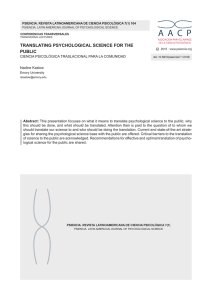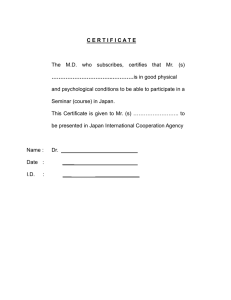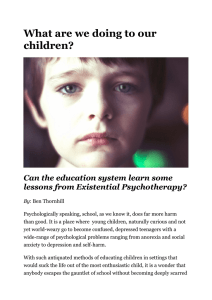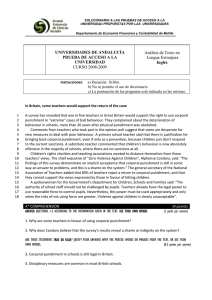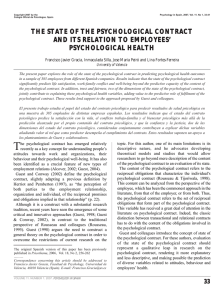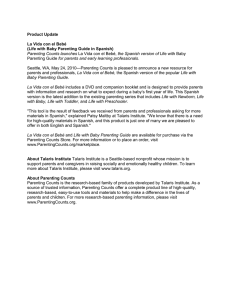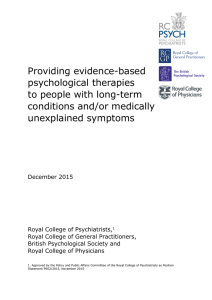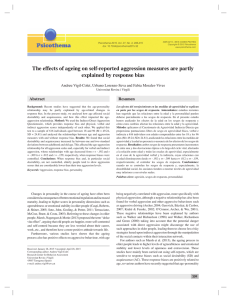Corporal punishment and long-term behavior problems
Anuncio
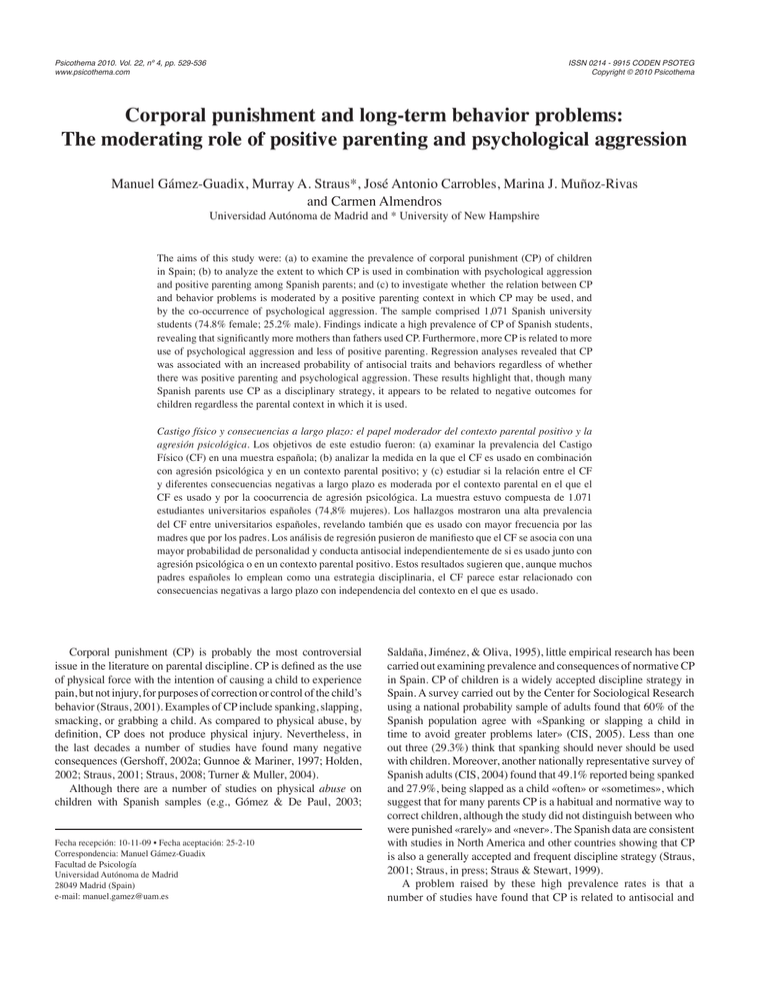
Psicothema 2010. Vol. 22, nº 4, pp. 529-536 www.psicothema.com ISSN 0214 - 9915 CODEN PSOTEG Copyright © 2010 Psicothema Corporal punishment and long-term behavior problems: The moderating role of positive parenting and psychological aggression Manuel Gámez-Guadix, Murray A. Straus*, José Antonio Carrobles, Marina J. Muñoz-Rivas and Carmen Almendros Universidad Autónoma de Madrid and * University of New Hampshire The aims of this study were: (a) to examine the prevalence of corporal punishment (CP) of children in Spain; (b) to analyze the extent to which CP is used in combination with psychological aggression and positive parenting among Spanish parents; and (c) to investigate whether the relation between CP and behavior problems is moderated by a positive parenting context in which CP may be used, and by the co-occurrence of psychological aggression. The sample comprised 1,071 Spanish university students (74.8% female; 25.2% male). Findings indicate a high prevalence of CP of Spanish students, revealing that significantly more mothers than fathers used CP. Furthermore, more CP is related to more use of psychological aggression and less of positive parenting. Regression analyses revealed that CP was associated with an increased probability of antisocial traits and behaviors regardless of whether there was positive parenting and psychological aggression. These results highlight that, though many Spanish parents use CP as a disciplinary strategy, it appears to be related to negative outcomes for children regardless the parental context in which it is used. Castigo físico y consecuencias a largo plazo: el papel moderador del contexto parental positivo y la agresión psicológica. Los objetivos de este estudio fueron: (a) examinar la prevalencia del Castigo Físico (CF) en una muestra española; (b) analizar la medida en la que el CF es usado en combinación con agresión psicológica y en un contexto parental positivo; y (c) estudiar si la relación entre el CF y diferentes consecuencias negativas a largo plazo es moderada por el contexto parental en el que el CF es usado y por la coocurrencia de agresión psicológica. La muestra estuvo compuesta de 1.071 estudiantes universitarios españoles (74,8% mujeres). Los hallazgos mostraron una alta prevalencia del CF entre universitarios españoles, revelando también que es usado con mayor frecuencia por las madres que por los padres. Los análisis de regresión pusieron de manifiesto que el CF se asocia con una mayor probabilidad de personalidad y conducta antisocial independientemente de si es usado junto con agresión psicológica o en un contexto parental positivo. Estos resultados sugieren que, aunque muchos padres españoles lo emplean como una estrategia disciplinaria, el CF parece estar relacionado con consecuencias negativas a largo plazo con independencia del contexto en el que es usado. Corporal punishment (CP) is probably the most controversial issue in the literature on parental discipline. CP is defined as the use of physical force with the intention of causing a child to experience pain, but not injury, for purposes of correction or control of the child’s behavior (Straus, 2001). Examples of CP include spanking, slapping, smacking, or grabbing a child. As compared to physical abuse, by definition, CP does not produce physical injury. Nevertheless, in the last decades a number of studies have found many negative consequences (Gershoff, 2002a; Gunnoe & Mariner, 1997; Holden, 2002; Straus, 2001; Straus, 2008; Turner & Muller, 2004). Although there are a number of studies on physical abuse on children with Spanish samples (e.g., Gómez & De Paul, 2003; Fecha recepción: 10-11-09 • Fecha aceptación: 25-2-10 Correspondencia: Manuel Gámez-Guadix Facultad de Psicología Universidad Autónoma de Madrid 28049 Madrid (Spain) e-mail: [email protected] Saldaña, Jiménez, & Oliva, 1995), little empirical research has been carried out examining prevalence and consequences of normative CP in Spain. CP of children is a widely accepted discipline strategy in Spain. A survey carried out by the Center for Sociological Research using a national probability sample of adults found that 60% of the Spanish population agree with «Spanking or slapping a child in time to avoid greater problems later» (CIS, 2005). Less than one out three (29.3%) think that spanking should never should be used with children. Moreover, another nationally representative survey of Spanish adults (CIS, 2004) found that 49.1% reported being spanked and 27.9%, being slapped as a child «often» or «sometimes», which suggest that for many parents CP is a habitual and normative way to correct children, although the study did not distinguish between who were punished «rarely» and «never». The Spanish data are consistent with studies in North America and other countries showing that CP is also a generally accepted and frequent discipline strategy (Straus, 2001; Straus, in press; Straus & Stewart, 1999). A problem raised by these high prevalence rates is that a number of studies have found that CP is related to antisocial and 530 MANUEL GÁMEZ-GUADIX, MURRAY A. STRAUS, JOSÉ ANTONIO CARROBLES, MARINA J. MUÑOZ-RIVAS AND CARMEN ALMENDROS criminal tendencies (Gámez-Guadix & Straus, 2008; GroganKaylor, 2004; Gunnoe & Mariner, 1997; Straus, 2001). A metaanalysis of 88 studies examined the link between CP and multiple negative outcomes (Gershoff, 2002a). It included 40 tests of the hypothesis that CP is associated with an increased probability of aggressive and delinquent behaviour by children. Thirty nine of the tests found this relationship. Similarly, eight of the nine tests of adult aggression and criminal behavior found the hypothesized link to physical punishment. It has been hypothesized that although CP produces compliance in the short term, in the long term it may increase the probability of deviance, including antisocial tendencies. In addition, CP has been associated with a number of negative mental health outcomes, such as depression, anxiety, suicide, or alcohol abuse (Gershoff, 2002a; McLoyd, Jayaratne, Ceballo, & Borquez, 1994; Straus, 2001; Turner & Muller, 2004). Some researchers, however, dispute the validity of this evidence and have recommended conditional use of physical punishment under certain conditions (Larzelere, 2000), for example, as a backup when used in a non abusive customary way. They dispute the validity of the studies showing harmful side-effects on a number of grounds. For example, they argue that the studies have often confounded mild CP with more severe types of harsh punishment and that this explains the harmful side-effects (Larzelere, 1996, 2000; Ripoll-Núñez & Rohner, 2006). Another criticism is that the research has failed to take into account contextual factors, such as a positive parenting context (Benjet & Kazdin, 2003; Gershoff, 2002a; Ripoll-Núñez & Rohner, 2006). The critics believe that when CP is used by loving and caring parents in a positive context it is harmless. However, studies examining the potential moderation effects of parental warmth and support on CP outcomes have been scarce and inconsistent (Harper, Brown, Arias, & Brody, 2006; Simons, Lin, & Gordon, 1998; Straus & Mouradian, 1998). It has also been suggested that what seems to be an harmful effect of CP may be spurious because of confounding with psychological aggression. In research on family violence, terms such as emotional abuse, psychological abuse, or verbal/ symbolic aggression have often been used as synonyms for psychological aggression (Almendros, Gámez-Guadix, Carrobles, Rodríguez-Carballeira, & Porrúa, 2009). As conceptualized here, psychological aggression refers to a communication intended to cause psychological pain to another person, or a communication perceived as having that intent. The communicative act may be active or passive, and verbal or nonverbal (Vissing, Straus, Gelles, & Harrop, 1991). Research on CP and psychological aggression indicates that they tend to co-occur (Bartkowski & Wilcox, 2000; Wissow, 2001) and that the psychological and verbal aggression may be the underlying variable that accounts for the relationship of CP to externalizing behavior problems and poorer mental health (Vissing et al., 1991). However, because there is little empirical research on the extent to which the effects of CP may be due the co-occurrence of psychological aggression, it is difficult to conclude that the consequences associated with CP are because psychological aggression habitually covaries with physical discipline (Holden, 2002; Parke, 2002). The present study The aims of this study were (a) to provide data on the prevalence of CP of a sample of children in Spain; (b) to examine the extent to which CP is used in combination with psychological aggression and positive parenting among Spanish parents; and (c) to investigate if the relation between CP and behavior problems is moderated by a positive parenting context in which CP may be used and by the co-occurrence of psychological aggression. Based on previous research that has shown that CP is associated with negative outcomes later in life (Gershoff, 2002a), we hypothesized that the experience of CP as a child is significantly related to a higher rate of antisocial tendencies and depressive symptoms as an adult regardless whether CP occurs within a positive parenting context and regardless whether psychological aggression is also present. Method Participants The participants in this study were a university student sample from the Community of Madrid, which was gathered as part of International Parenting Study (http://pubpages.unh.edu/~mas2/IPS. htm), a research project conducted by a consortium of researchers in over 20 countries all over the world. The initial sample was composed of 1,343 participants. Because of the purposes of the study, only students living with two parents or step parents at age of ten were included in the study (N= 1,270; 94.6%). To avoid confounding CP with physical abuse, we excluded students who had reported any example of physical abuse (N= 199; 15.7%), using five items from the CTSPC (Straus, Hamby, Finkelhor, Moore, & Runyan, 1998). The final sample used in this analysis was composed of 1,071 university students (74.8% female; 25.2% male) with a mean age of 21.20 (SD= 4.29). Thirty-eight percent of participants were students of Psychology, 17.8% of Law, 15.5% of Education, 10.5% of Economy, 10% of Science, and 7.9% of Art and Humanities. The purpose of the study and the right to refuse to participate were explained to all students. They were assured of anonymity and confidentiality, and given a debriefing form that explained the study in more detail after participants had completed all of the measures. The students were also provided contact information for area agencies should they need assistance with mental health or violence problems. All procedures were reviewed and approved by the University Ethics Board. Measures Dimensions of Discipline Inventory (DDI). The Corporal Punishment and Psychological Aggression scales of the AdultRecall form of the DDI (Straus & Fauchier, 2007) were used in this study. The students were asked to answer the DDI questions for the year they were ten years old. Each question was repeated for the behavior of the mother and the father. The 10-response categories ranged from N (Never) through 9 (Two or more times a day). The DDI has demonstrated good construct validity and acceptable internal consistency reliability in Spanish university students (Gámez-Guadix et al., 2010). The DDI scale to measure CP has four questions, but for this study only the following two questions were used: «How often did your mother/father spank, slap, smack, or swat you?» and «How often did you shake or grab this child to get their attention?». The question «How often did you use a paddle, hairbrush, belt, or other object?» was not used to avoid confounding with what many would CORPORAL PUNISHMENT AND LONG-TERM BEHAVIOR PROBLEMS: THE MODERATING ROLE OF POSITIVE PARENTING AND PSYCHOLOGICAL AGGRESSION consider physical abuse. The question «How often did you wash this child’s mouth out with soap, put hot sauce on their tongue, or something similar?» was not used because it was not culturally appropriate in the Spanish context. The questions used to measure psychological aggression were: «How often did you shout or yell at this child?», «How often did you try to make this child feel ashamed or guilty?», «How often did you hold back affection by acting cold or not giving hugs or kisses?», and «When this child behaved badly, how often did you tell the child that they are lazy, sloppy, thoughtless, or some other name like that?». Positive Parenting Scale. The adult-recall form of the DDI was examined to identify parent behaviors that could be considered indicators of positive parenting. The following four behaviors were selected: «Did or said things to show that they loved and supported you», «Explained why they did what they did to correct you», «Felt encouraged and supported», and «Checked on you so that they could tell you that you were doing a good job». Because each is asked for father and for mother, there are a total of eight items. A factor analysis of a sample of 1,313 University of New Hampshire students specifying a single factor showed that this factor explained 48.4% of the variance, and that all items had factor loadings above .4. The scale was created by transforming the eight items to z scores, summing the z scored items, and transforming the sum to a z score. In the current study, Cronbach’s α was .78. Short form of Antisocial traits and behavior (ATB) Scale. This scale is derived from the DSM-IV (American Psychiatric Association, 1994). Because the DSM-IV definition of Antisocial Personality Disorder includes criminal behavior, both before and after age 15, the scale combines five items of the Antisocial Personality Traits Scale and three items of the Criminal History Scale of the Personal and Relationship Profile (Straus, Hamby, Boney-McCoy, & Sugarman, 1997). Although the questions were derived from the DSM-IV definition of antisocial personality, this scale was not intended to be a diagnostic tool. Examples of the nine Antisocial Personality Traits and Behavior items are «I don’t think about how what I do will affect other people» and «Since age 15, I have physically attacked someone with the idea of seriously hurting them». The eight items comprising both subscales were summed and divided by the number of items to obtain a mean ATB score. For this study, the internal consistency (Chronbach’s α) was .68. Major Depression Inventory, MDI (Olsen, Jensen, Noerholm, Martiny, & Bech, 2003). This instrument contains 12 items that cover the ICD-10 symptoms of depression. The items ask the participant to rate how much time in the past two weeks each of the symptoms was present using a Likert-type response categories ranging from 0 (At no time) to 5 (All of the time). Examples of items include «Have you felt low in spirits or sad?» and «Have you lost interest in your daily activities?». This scale has demonstrated good construct validity and internal consistency reliability (Cuijpers, Dekker, Noteboom, Smits, & Peen, 2007; Olsen et al., 2003). For this study, the overall alpha coefficient of internal consistency reliability was .87. Limited Disclosure Scale. The tendency of some participants to minimize disclosure of socially undesirable behavior was controlled using a reduced version of the Limited Disclosure Scale of the PRP. This is a 6-item scale based on Reynolds short-form Social Desirability subscale (Reynolds, 1982). It includes behaviors and 531 emotions that are slightly undesirable but true of most people, such as «I sometimes try to get even rather than forgive and forget». Participants indicated on a four-point scale from 1 (Strongly Disagree) to 4 (Strongly Agree) the extent to which they agreed with each item. For this study, the internal consistency reliability of this scale was α= .56. Data analyses First, descriptive statistics and zero-order correlations were calculated for all variables in the study. Second, percentages and Chi-square test were calculated to analyze the prevalence for parent behavior and the differences as a function of sex of the participant and sex of the parent. Finally, multiple regression analyses were performed to the test the hypothesis regarding the relationship of CP, psychological aggression and dependent variables (ATB and depressive symptoms). Results Prevalence for parent behavior Corporal punishment. Sixty-three percent of males and 63.8% of females (X2(1)= .05; p= .82) were physically punished at age ten. In this study somewhat more mothers than fathers used CP (42.9% of fathers and 50.1% of mothers) (X2(1)= 8.05; p<.05), whereas in the Fauchier and Straus North American International Parenting Study there was very little difference (23% of fathers and 27% of mothers spanked, slapped, smacked, or swatted their children). In respect to shaking and grabbing a child, the percentages were 34.5% of fathers and 39% of mothers among Spanish parents (X2(1)= 2.92; ns) compared to 24% and 25% of U.S. fathers and mothers. More mothers (56.5%) than fathers (50%) used any kind of CP (X2(1)= 6.08; p<.05). Eighty-three percent of mothers and 78.8% of fathers who shook or grabbed their children also spanked, slapped, smacked or swatted them. This indicates that these behaviors of CP tend to co-occur. Psychological aggression. Eighty-six percent of males and 86.9% of females reported any kind of psychological aggression (X2(1)= .14; ns). Eighty-seven percent of mothers and 81.1% of fathers shouted or yelled the child (X2(1)= 12.2; p<.001), 47.2% of mothers and 45.1% of fathers tried to make the child feel ashamed or guilty (X2(1)= .92; ns), 27.7% of mothers and 28.2% of fathers hold back affection to the child (X2(1)= 0.64; ns), and 61.6% of mothers and 59% of fathers told the child that they are lazy, sloppy, thoughtless, or some other name like that (X2(1)= 1.52; ns). More than ninety percent of mothers (91.7%) and 89.3% of fathers used any kind of psychological aggression (X2(1)= 3.39; ns). Positive parenting. The total positive parenting score was higher for females than for males (t= -2.12; p<.05). More than eighty percent of mothers and fathers (88.5% and 83.5%, respectively) did or said things to show that they loved and supported the child (X2(1)= 10.8; p<.01), 84.8% of mothers and 78.9% of fathers explained why they did what they did to correct the child (X2(1)= 12.1; p<.01), 85.3% of mothers and 82.7% of fathers tried to encourage and support the child (X2(1)= 2.59; ns), and 74.6% of mothers and 70.1% of fathers checked on the child so that they could tell you that were doing a good job (X2(1)= 5.15; p<.05). 532 MANUEL GÁMEZ-GUADIX, MURRAY A. STRAUS, JOSÉ ANTONIO CARROBLES, MARINA J. MUÑOZ-RIVAS AND CARMEN ALMENDROS Prevalence for child behavior reported five or six symptoms, and 5.7% reported more than seven symptoms. Antisocial and criminal behavior (ATB). The mean of ATB was higher for males (M= 13.83 ; SD= 3.66) than for females (M= 11.30; SD= 2.63) (t = 11.78; p<.001). The percentage of participants who do not agree or strongly agree with any items of ATB was 54.8%. More than one out third of participants (36.1%) agree or strongly agree with one or two items, 7.7% with three or four items, and 1.4% with 5 or more items. Depressive Symptoms. The total score for depressive symptoms was not different between males (M= 13.02; SD= 9.12) and females (M= 12.88; SD= 8.59) (t= .21; ns). Thirty percent of participants reported one or two symptoms in the last two weeks more than half of the time, 10.7% reported three or four symptoms, 5.3% Correlation analysis The first column of Table 1 shows that the strongest correlation was between CP and psychological aggression (r= .54; p<.001), indicating that the more CP the more psychological aggression. Indeed, 86.2% of parents who use CP also used psychological aggression. Alternatively, 69.6% of parents who use psychological aggression also used CP. The second correlation in the first column of Table 1 shows that the correlation of .16 (p<.001) between CP and positive parenting indicates that the more CP used, the less the degree of positive parenting . Psychological aggression and positive Table 1 Zero-order correlations of the variables in the study 1 2 3 4 5 6 7 8 1. Corporal punishment 2. Psychological aggression .54*** 3. Positive parenting -.16*** -.28*** 4. Antisocial traits and behaviors .20*** -.26*** -.17*** 5. Depression .12*** .23*** -.20*** .19*** 6. Sex (1= men; 2= women) -.06* -.11** .06* -.35*** 7. Age -.02* -.11** -.05 -.04 -.06* -.06* 8. Parents’ education level -.01 0.01 .08* .05 -.07* -.12*** -.12*** -.01* -.16*** 0-.24*** .23*** -.40*** -.23*** .01 -.11** -.040 M 4.14* 14.66** .44 11.93* 12.92 1.75* 21.20 -3.63 SD 5.40 11.28* 5.33* 3.12* 8.72 .43* 4.29 -1.66 9. Limited disclosure Note: * p<.05; **p<.01; ***p<.001 Table 2 Summary of hierarchical regression analysis predicting Antisocial Traits and Behaviors Step 1 Step 2 B β Sex (1= men; 2= women) -.80 Age -.01 Limited Disclosure Parents’ education level Step 3 B β -.35*** -.79 -.03 -.01 -.15 -.40*** -.02 -.04 Corporal punishment (CP) Step 4 B β -.35*** -.78 -.03 -.01 -.14 -.38*** -.02 -.04 .10 .10*** Psychological aggression Step 5 B β B β -.35*** -.78 -.03 -.01 -.35*** -.78 -.35*** -.03 -.01 -.03 -.14 -.37*** -.02 -.04 -.14 -.36*** -.14 -.36*** -.02 -.03 -.02 -.04 .11 .08 .10*** .10 .10** .23 .22* .07** .07* .07* .06 .06* -.05 -.05 † -.05 -.05 † .03 .04 Positive parenting CP x sex CP x Psychological Aggression .01 .01 CP x Positive Parenting -.08 -.13 R2 .29 ΔF 88.97*** † * Note: p<.10; p<.05; **p<.01; ***p<.001 .30 12.30*** .31 6.86** .31 .31 † 3.07 1.20 533 CORPORAL PUNISHMENT AND LONG-TERM BEHAVIOR PROBLEMS: THE MODERATING ROLE OF POSITIVE PARENTING AND PSYCHOLOGICAL AGGRESSION parenting were also related (r= -.28; p<.001), indicating that the more psychological aggression the less positive parenting. 4.4 4.3 4.2 4.1 4,3 ATB 3.9 3.8 3.7 3.6 3.5 3.4 Multiple Regression Analysis To overcome the overlap between psychological aggression and CP in order to analyze the distinctive contribution of each, the items from both scales were factor analyzed using the AndersonRubin method and Varimax rotation. The Anderson-Rubin method produces factor scores that are uncorrelated and standardized (Field, 2005). Prior to factor analysis, examination of sampling adequacy indices indicated that the data contained sufficient shared variance for factor analysis: KMO= .70; Bartlett’s Test of Sphericity= 7,326.11, p<.001. One item («Shout or yell the child») was not loaded in the psychological aggression factor and was excluded in further analysis. The factor analyses yielded a two factor solution (Corporal punishment and Psychological aggression) with all items having factor loadings above .5. Psychological aggression factor accounted for 41.69% of total item variance and Corporal punishment factor accounted for 16.19% of total item variance. Factor scores for each factor were added to the data for each study participant. Regression analyses were carried out using as independent variables the factor scores of CP and psychological aggression. Sex, age, limited disclosure, and educative level were introduced in the step 1 as control variables. In steps 2, 3, and 4, CP, psychological aggression, and positive parenting were introduced one by step at a time in order to analyze the change when introduced. Finally, interactions terms were introduced in the last step. Antisocial Traits And Behavior (ATB). The first set of regression analyses tested the relation of CP, psychological aggression, and positive parenting to ATB (see Table 2). In step 1, ATB was regressed on the control variables. The results indicate that sex and limited disclosure were significantly related to ATB. In step 2, CP was added to the regression equation. As expected, CP was significantly related to higher ATB scores while controlling Low High Corporal punishment Low Psych. Aggression High Psych. Aggression Figure 1. Level of Antisocial Traits and Behaviors (ATB) as a function of Corporal Punishment and Psychological Aggression 4.3 4.2 4.1 4,0 3.9 ATB 3.8 3.7 3.6 3.5 3.4 3.3 Low High Corporal punishment Low Positive Parenting High Positive Parenting Figure 2. Level of Antisocial Traits and Behaviors (ATB) as a function of Corporal Punishment and Positive Parenting Table 3 Summary of hierarchical regression analysis predicting Depressive Symptomatology Step 1 Step 2 B β B Step 3 β Step 4 B β Step 5 B β B β Sex (1= men; 2= women) -.05 -.02 -.04 -.02 -.03 -.01 -.01 -.01 -.02 -.01 Age -.01 -.05 -.01 -.05 -.01 -.05 -.01 -.06 -.01 -.06 Limited Disclosure -.09 -.23*** -.09 -.23*** -.08 -.19*** -.07 -.17*** -.07 -.17*** Educative Level -.05 -.09** -.05 -.09** -.06 -.09** -.05 -.08** -.05 -.09** .04 .03 Corporal punishment (CP) Psychological aggression .05 .04 .04 .04 -.17 -.16 .20 .19*** .18 .17*** .18 .17*** -.11 -.11** Positive parenting -.11 -.11** CP x sex -.00 -.00 CP x Psychological Aggression -.03 -.03 CP x Positive Parenting .12 R2 ΔF † * Note: p<.10; p<.05; **p<.01; ***p<.001 .20 .06 .06 .10 .11 .11 15.40*** 1.12 34.16*** 10.98** 1.21 534 MANUEL GÁMEZ-GUADIX, MURRAY A. STRAUS, JOSÉ ANTONIO CARROBLES, MARINA J. MUÑOZ-RIVAS AND CARMEN ALMENDROS for demographic variables and limited disclosure. Step 3 shows that psychological aggression was also a significant predictor of ATB. In step 4 positive parenting was added to the equation. After controlling the effect of the others factors, positive parenting was only marginally related to the outcome. CP was still a significant predictor of ATB regardless of the degree of psychological aggression and positive parenting. Finally, the interaction terms of CP with sex, psychological aggression and positive parenting were added simultaneously to the equation in Step 5. None of these interactions were significant, indicating that the relationship of CP to ATB applies to both men and women, and to students whose parents were low in psychological aggression as well as those whose parents were high in psychological aggression, as shown in Figures 1 and 2. Figures were created by plotting high and low values of predictor and moderator variables (1 SD above and 1 SD below the mean of standardized variables) based on the recommendations by Holmbeck (1997) to examine the nature of interaction effects. Using the codification for frequency at age of ten proposed in the manual of the DDI (Straus and Fauchier, 2007, p. 31), 1 SD below the mean of CP (Low CP in Figures 1 and 2) corresponds to no examples of CP at age of ten and 1 SD above the mean (High CP) is, approximately, 24 examples of CP at age of ten. Depressive Symptoms. A second model was estimated for the relation of CP, psychological aggression, and positive parenting to depressive symptoms (Table 3). Following the same steps as for ATB, the control variables were entered in the equation in Step 1. Limited disclosure and education level were significantly associated with depressive symptoms. In step 2, CP was added to the equation. Results indicate that CP was not a significant predictor of depression after controlling for the demographic variables and limited disclosure. Psychological aggression and positive parenting were added to the equation in step 3 and step 4, respectively. As expected, both were a significant predictor of depression. In Step 5 interaction terms of CP with gender, psychological aggression and positive parenting are added to the equation. None were statistically significant, indicating that the relation of psychological aggression to depressive symptoms applies regardless of gender and positive parenting. use of reasoning as a disciplinary practice). Other studies have also reported this relationship between power-assertive tactics and positive parenting (Wissow, 2001). Overall, these findings indicate that there is a group of parents who tend to rely on aggressive discipline. Parents who use aggressive power-assertion tactics, use a lower proportion of positive parenting strategies. It is important to acknowledge these associations because they suggest that encouraging mothers and fathers to not use CP could also reduce use of other aggressive strategies and promote more positive parenting strategies. CP was found to be linked to an increased probability of ATB regardless of whether there was positive parenting. This is an important result because it provides empirical evidence contradicting the claim that CP has no negative consequences when is used by loving and supportive parents (Larzelere, 2000; Ripoll-Núñez & Rohner, 2006). Also, we did not find a significant interaction of CP with psychological aggression. The importance of this result is that it contradicts the belief that the link between CP and child behavior problems occurs because psychological aggression often accompanies CP. These results suggest that CP per se is a risk factor for developing an antisocial orientation, as has been found in two longitudinal studies (Gunnoe & Mariner, 1997; Straus, Sugarman, & Giles-Sims, 1997) and with the results of a meta analysis of research on CP (Gershoff, 2002a) which found a large and unusually consistent body of research showing that CP tends to be an important risk factor for deviant behavior. Several mechanisms, such as less child internalization of parents’ values and low self-control, may explain the relationship between CP and an antisocial orientation (Gottfredson & Hirschi, 1994). Overall, the results are congruent with the idea that although CP might produce conformity in the immediate situation, in the long term it may increase the probability of deviance, including antisocial tendencies (Straus et al., 1997; Straus, 1991, 2001). This study found the hypothesized relation between CP and depression at the bivariate level, but not when the other variables in the study were controlled. It is possible that the type of sample (i.e., highly educated university students) attenuate the association between these variables. Future studies should attempt to further specify the conditions in which CP and depressive sympotomatology are related in the Spanish cultural context. Discussion Limitations We studied a Spanish sample of university students and, consistent with studies with American samples (Straus, 2001; Straus & Stewart, 1999), found high rates of CP by parents. Specifically, more than 60% of the male and the female students were physically hit at age of ten. The prevalence rates found in the present study are higher than those found using the same methodology and criteria for North American students in the International Parenting Study (Fauchier & Straus, 2007). Futures studies should attempt to better understand the social and cultural variables that may explain the much higher percent of Spanish parents who use CP and the greater difference between Spanish fathers and mothers. Findings indicated that CP and psychological aggression tend to go together. Almost 9 out 10 of parents who used CP also used psychological aggression, which is consistent with previous studies (Bartkowski & Wilcox, 2000; Wissow, 2001). Higher levels of both CP and psychological aggression are also related to lower levels of positive parenting practices (i.e., parental support, warmth, and First, this study focused on the preadolescent period because it was more likely than younger ages to evoke adequate recall (Fauchier & Straus, 2008). However, the effects of CP may differ on children at different ages (Gershoff, 2002a). Thus, the impact of CP during preadolescence may be different from impact of CP at earlier periods and, therefore, results about the consequences of CP at preadolescence cannot be generalized to other developmental periods. In addition, regardless of age-specificity issues, the study relies on retrospective self-report, which may have produced memory biases. A second limitation is that the cross-sectional design does not permit establishing the causal direction. This is particularly important in the case of CP because that is something parents typically do to correct misbehavior (Gámez-Guadix & Straus, 2008). Thus, corporal punishment, rather than being a cause of later antisocial orientation, may be a consequence of child behavior problem behavior, which carries over into adulthood. However, CORPORAL PUNISHMENT AND LONG-TERM BEHAVIOR PROBLEMS: THE MODERATING ROLE OF POSITIVE PARENTING AND PSYCHOLOGICAL AGGRESSION there are at least seven longitudinal studies which show that although misbehavior does cause CP and does result in cessation of the misbehavior at the time, in the longer run use of CP boomerangs in the sense of increasing the probability of subsequent antisocial behavior (Straus, 2001). Conclusions The present study is one of the first to document the prevalence of CP by both mothers and fathers and for males and females in Spain. The results show that a considerable percentage of male and female students in this research reported having been physically hit in the preadolescence, and very high rates of psychological aggression as a means of correcting child misbehavior. In addition, although both opponents and defenders of CP agree that severe physical discipline is harmful, the results of this study, along with other empirical research, show that mild and moderate CP is also related to child behavior problems. Taken together, these results indicate that a large percentage of Spanish parents use aggressive 535 modes of discipline that we and others have found to be related to behavior problems as young adults. This study extends the existing literature by taking into account two important aspect of the context in which CP is used in an unstudied population. The findings suggest that Spanish parents be encouraged to avoid CP as well as psychologically aggressive discipline methods and to use alternative forms of correction of child misbehavior. As Gershoff (2002b) and others have argued, parent education programs that emphasize alternative disciplinary tactics to CP and psychological aggression may make an important contribution to the well-being of Spanish children. Acknowledgements It is a pleasure to express appreciation to members of the 2008-2009 Family Research Laboratory Seminar for valuable comments and suggestions. The work was supported by a research grant from Department of Education and Science of Spain (AP2005-0854). References Almendros, C., Gámez-Guadix, M., Carrobles, J.A., Rodríguez-Carballeira, A., & Porrúa, C. (2009). Intimate partner psychological abuse: Recent contributions, concept and measurement. Behavioral Psychology, 17, 433-451. Bartkowski, J.P., & Wilcox, W.B. (2000). Conservative protestant child discipline: The case of parental yelling. Social Forces, 79, 263-290. Benjet, C., & Kazdin, A.E. (2003). Spanking children: The controversies, findings and new directions. Clinical Psychology Review, 23, 197-224. CIS (2004). Opiniones y actitudes sobre la familia. Retreived from http:// www.cis.es/cis/export/sites/default/-Archivos/Marginales/2560_2579/ Es2578.pdf. CIS (2005). Actitudes y opiniones sobre la infancia. Retrieved from http:// www.cis.es/cis/opencm/ES/1_encuestas/estudios/ver.jsp?estudio=5197 &cuestionario=5510&muestra=9843. Cuijpers, P., Dekker, J., Noteboom, A., Smits, N., & Peen, J. (2007). Sensitivity and specificity of the Major Depression Inventory in outpatients. BMC Psychiatry, 7. Fauchier, A., & Straus, M.A. (2007). Dimensions of discipline by fathers and mothers as recalled by university students. Durham, NH: Family Research Laboratory, University of New Hampshire. http://www. pubpages.unh.edu/~mas2/. Gámez-Guadix, M., Orue, I., Calvete, E., Carrobles, J.A., Muñoz-Rivas, M., & Almendros, C. (2010). Psychometric properties of the Spanish version of the Dimensions of Discipline Inventory (DDI) in university students. Psicothema, 22, 151-156. Gámez-Guadix, M., & Straus, M.A. (2008). Childhood and adolescent victimization and sexual coercion and assault by male and female university students. Durham, NH: Family Research Laboratory, University of New Hampshire. Gershoff, E.T. (2002a). Corporal punishment by parents and associated child behaviors and experiences: A meta-analytic and theoretical review. Psychological Bulletin, 128, 539-579. Gershoff, E.T. (2002b). Corporal punishment, physical abuse and the burden of proof: Reply to Baumrind, Larzelere and Cowan (2002), Holden (2002), and Parke (2002). Psychological Bulletin, 128, 602611. Gómez, E., & De Paul, J. (2003). La transmisión intergeneracional del maltrato físico infantil: estudio en dos generaciones. Psicothema, 15, 452-457. Gottfredson, M.R., & Hirschi, T. (1994). A general theory of adolescent problem behavior: Problems and prospects. Hillsdale, NJ, England: Lawrence Erlbaum Associates, Inc. Grogan-Kaylor, A. (2004). The effect of corporal punishment on antisocial behavior in children. Social work research, 28, 153-162. Gunnoe, M.L., & Mariner, C.L. (1997). Toward a developmental-contextual model of the effects of parental spanking on children’s aggression. Archives of Pediatrics & Adolescent Medicine, 151, 768-775. Harper, F.W.K., Brown, A.M., Arias, I., & Brody, G. (2006). Corporal punishment and kids: How do parent support and gender influence child adjustment? Journal of Family Violence, 21, 197-207. Holden, G.W. (2002). Perspectives on the effects of corporal punishment: Comment on Gershoff (2002). Psychological Bulletin, 128, 590-595. Holmbeck, G.N. (1997). Toward terminological, conceptual and statistical clarity in the study of mediators and moderators: Examples from the child-clinical and pediatric psychology literatures. Journal of Consulting and Clinical Psychology, 65, 599-610. Larzelere, R.E. (1996). A review of the outcomes of parental use of nonabusive or customary physical punishment. Pediatrics, 98, 828-831. Larzelere, R. (2000). Child outcomes of nonabusive and customary physical punishment by parents: An updated literature review. Clinical Child and Family Psychology Review, 3, 199. McLoyd, V.C., Jayaratne, T.E., Ceballo, R., & Borquez, J. (1994). Unemployment and work interruption among African American single mothers: Effects on parenting and adolescent socioemotional functioning. Child Development, 65, 562-589. Olsen, L.R., Jensen, D.V., Noerholm, V., Martiny, K., & Bech, P. (2003). The internal and external validity of the Major Depression Inventory in measuring severity of depressive states. Psychological Medicine, 33, 351-356. Parke, R.D. (2002). Punishment revisited-Science, values and the right question: Comment on Gershoff (2002). Psychological Bulletin, 128, 596-601. Reynolds, W. (1982). Development of reliable and valid short forms of the Marlowe-Crowne Social Desirability Scale. Journal of Clinical Psychology, 38, 119. Ripoll-Núñez, K.J., & Rohner, R.P. (2006). Corporal punishment in crosscultural perspective: Directions for a research agenda. Cross-Cultural Research: The Journal of Comparative Social Science, 40, 220-249. Saldaña, D., Jiménez, Jr., & Oliva, A. (1995). El maltrato infantil en España: un estudio a través de los expedientes de menores. Infancia y Aprendizaje, 71, 59-68. Simons, R.L., Lin, K.H., & Gordon, L.C. (1998). Socialization in the family of origin and male dating violence: A prospective study. Journal of Marriage & the Family, 60, 467-478. 536 MANUEL GÁMEZ-GUADIX, MURRAY A. STRAUS, JOSÉ ANTONIO CARROBLES, MARINA J. MUÑOZ-RIVAS AND CARMEN ALMENDROS Straus, M. (1991). Discipline and deviance: Physical punishment of children and violence and other crime in adulthood. Social problems, 38, 133. Straus, M.A. (2001). Beating the devil out of them: Corporal punishment in American families and its effects on children. New Brunswick, NJ, US: Transaction Publishers. Straus, M.A. (2008). The special issue on prevention of violence ignores the primordial violence. Journal of Interpersonal Violence, 23, 13141320. Straus, M.A. (in press). Prevalence and societal causes of corporal punishment by parents in world perspective. Law And Contemporary Problems, Duke University. Straus, M.A., & Fauchier, A. (2007). Manual for the Dimensions of Discipline Inventory (DDI). Durham, NH: Family Research Laboratory, University of New Hampshire http://www.pubpages.unh.edu/~mas2/. Straus, M.A., Sugarman, D.B., & Giles-Sims, J. (1997). Spanking by parents and subsequent antisocial behavior of children. Archives of Pediatric and Adolescent Medicine, 151, 761-767. Straus, M.A., Hamby, S.L., Finkelhor, D., Moore, D.W., & Runyan, D. (1998). Identification of child maltreatment with the Parent-Child Conflict Tactics Scales: Development and psychometric data for a national sample of American parents. Child Abuse & Neglect, 22, 249270. Straus, M.A., Hamby, S.L., Boney-McCoy, S., & Sugarman, D. (1999, Revised 2007). Manual for the Personal and Relationships Profile (PRP). Durham, NH: University of New Hampshire, Family Research Laboratory. Available in: http://www.pubpages.unh.edu/~mas2/. Straus, M.A., & Mouradian, V.E. (1998). Impulsive corporal punishment by mothers and antisocial behavior and impulsiveness of children. Behavioral Sciences & the Law, 16, 353-374. Straus, M.A., & Stewart, J.H. (1999). Corporal punishment by American parents: National data on prevalence, chronicity, severity and duration, in relation to child and family characteristics. Clinical Child and Family Psychology Review, 2, 55-70. Turner, H.A., & Muller, P.A. (2004). Long-term effects of child corporal punishment on depressive symptoms in young adults: Potential moderators and mediators. Journal of Family Issues, 25, 761-782. Vissing, Y.M., Straus, M.A., Gelles, R.J., & Harrop, J.W. (1991). Verbal aggression by parents and psychosocial problems of children. Child Abuse & Neglect, 15, 223-238. Wissow, L.S. (2001). Ethnicity, income and parenting contexts of physical punishment in a national sample of families with young children. Child Maltreatment, 6, 118-129.
